
Watch our recent LIVE Q&A Session with professors from the University of Salamanca! Click here to learn more about online courses.
Universidad de Salamanca (USAL) and Center for Applied Linguistics (CAL) announce a multi-year strategic partnership for professional development for Spanish teachers.
In 2020-2021, USAL and CAL are collaborating to offer 10 asynchronous online courses on a variety of relevant topics for all learners and levels.
Courses include teaching grammar, development of hands-on language activities, digital teaching strategies, enhancing student motivation and collaboration, use of information and communications technology (ICT), appropriate use social media networks, and other complementary tools to make the Spanish language come to life!
Upcoming courses for the Fall/Winter semester:
- Principles of Digital Tools in the Spanish Classroom: How—and When—to Use Social Media to Engage Learners | “Herramientas didácticas digitales para el aula de español como lengua extranjera (ELE): las redes sociales”
- Principles to Practice: Tapping into Social Networks to Engage Your Spanish Learners | “Las redes sociales en el aula de español como lengua extranjera (ELE)”
- How to Teach Spanish Grammar that’s Accessible – Novice | “La enseñanza de la gramática a alumnos de niveles iniciales (A)”
- How to Teach Spanish Grammar that’s Accessible – Intermediate | “La enseñanza de la gramática a alumnos de niveles (B)”
- Games in the Spanish Language Classroom | Los juegos en el aula de español como lengua extranjera (ELE))
- The Spanish Teacher’s Roadmap: Challenges, Guidelines, and Tools | “El camino del professor de español como lengua extranjera (ELE): retos, pautas y herramientas”
- Music in the Spanish Language Classroom | “La música en el aula del español como lengua extranjera (ELE)”
- Interaction in Action: Teaching Strategies for a Dynamic Language Classroom | ”La interacción en acción”
- How to Teach Spanish Grammar that’s Accessible – Superior| “La enseñanza de la gramática a alumnos de niveles superiores (C)”
To browse all courses and reserve your seat, visit www.CALCommunities.org.
“Many of us are quarantined at home and are unable to travel,” said President & CEO, Dr. Joel Gómez speaking of the new international partnership. “The idea is to bring Spanish language, culture, and teaching to US classrooms in order to help teachers continue to maintain and improve their practice from the comfort of their home.”
“We are excited to partner with CAL to release our 10 most popular online courses for teachers of Spanish.” said Dr. Alberto Buitrago Jiménez, Spanish Language Professor for International Courses. “The purpose of these online courses is to help educators broaden their perspective and transform their pedagogical practic meet the needs of the 21st century. We are waiting to meet you!”
USAL and CAL bring centuries of experience in language teacher training and course management with proven results of preparing educators to build strong communities of Spanish learners.
The Center for Applied Linguistics (CAL)is a non-profit organization founded in 1959. Headquartered in Washington DC, CAL has earned an international reputation for its contributions to the fields of bilingual and dual language education, English as a second language, world languages education, language policy, assessment, immigrant and refugee integration, literacy, dialect studies, and the education of linguistically and culturally diverse adults and children. CAL’s mission is to promote language learning and cultural understanding by serving as a trusted resource for research, services, and policy analysis. Through its work, CAL seeks solutions to issues involving language and culture as they relate to access and equity in education and society around the globe.
Founded in 1218, la Universidad de Salamanca (USAL) is the world’s third oldest university and located in the city of Salamanca, west of Madrid, in the autonomous community of Castile and León. As the top-ranked university in Spain, Salamanca draws undergraduate and graduate students from across Spain and the world. It is known for its Spanish courses for non-native speakers (ELE – Español como Lengua Extranjera), which attracts more than 7,500 students each year and more than 1,000 students online. Today the University of Salamanca, “Universidad de Español,” is an important center for the study of humanities and is particularly noted for its language studies.
—
Contact:

